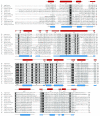Structural and kinetic characterization of quinolinate phosphoribosyltransferase (hQPRTase) from homo sapiens
- PMID: 17868694
- PMCID: PMC3326535
- DOI: 10.1016/j.jmb.2007.08.043
Structural and kinetic characterization of quinolinate phosphoribosyltransferase (hQPRTase) from homo sapiens
Abstract
Human quinolinate phosphoribosyltransferase (EC 2.4.2.19) (hQPRTase) is a member of the type II phosphoribosyltransferase family involved in the catabolism of quinolinic acid (QA). It catalyses the formation of nicotinic acid mononucleotide from quinolinic acid, which involves a phosphoribosyl transfer reaction followed by decarboxylation. hQPRTase has been implicated in a number of neurological conditions and in order to study it further, we have carried out structural and kinetic studies on recombinant hQPRTase. The structure of the fully active enzyme overexpressed in Escherichia coli was solved using multiwavelength methods to a resolution of 2.0 A. hQPRTase has a alpha/beta barrel fold sharing a similar overall structure with the bacterial QPRTases. The active site of hQPRTase is located at an alpha/beta open sandwich structure that serves as a cup for the alpha/beta barrel of the adjacent subunit with a QA binding site consisting of three arginine residues (R102, R138 and R161) and two lysine residues (K139 and K171). Mutation of these residues affected substrate binding or abolished the enzymatic activity. The kinetics of the human enzyme are different to the bacterial enzymes studied, hQPRTase is inhibited competitively and non-competitively by one of its substrates, 5-phosphoribosylpyrophosphate (PRPP). The human enzyme adopts a hexameric arrangement, which places the active sites in close proximity to each other.
Figures









Similar articles
-
Interactions at the 2 and 5 positions of 5-phosphoribosyl pyrophosphate are essential in Salmonella typhimurium quinolinate phosphoribosyltransferase.Biochemistry. 2010 Feb 23;49(7):1377-87. doi: 10.1021/bi9018219. Biochemistry. 2010. PMID: 20047307 Free PMC article.
-
Roles for cationic residues at the quinolinic acid binding site of quinolinate phosphoribosyltransferase.Biochemistry. 2010 Feb 23;49(7):1388-95. doi: 10.1021/bi9018225. Biochemistry. 2010. PMID: 20047306 Free PMC article.
-
A new function for a common fold: the crystal structure of quinolinic acid phosphoribosyltransferase.Structure. 1997 Jan 15;5(1):47-58. doi: 10.1016/s0969-2126(97)00165-2. Structure. 1997. PMID: 9016724
-
The sequencing expression, purification, and steady-state kinetic analysis of quinolinate phosphoribosyl transferase from Escherichia coli.Arch Biochem Biophys. 1996 Jan 15;325(2):270-8. doi: 10.1006/abbi.1996.0034. Arch Biochem Biophys. 1996. PMID: 8561507
-
Structural analyses reveal two distinct families of nucleoside phosphorylases.Biochem J. 2002 Jan 1;361(Pt 1):1-25. doi: 10.1042/0264-6021:3610001. Biochem J. 2002. PMID: 11743878 Free PMC article. Review.
Cited by
-
Structural Insights into the Quaternary Catalytic Mechanism of Hexameric Human Quinolinate Phosphoribosyltransferase, a Key Enzyme in de novo NAD Biosynthesis.Sci Rep. 2016 Jan 25;6:19681. doi: 10.1038/srep19681. Sci Rep. 2016. PMID: 26805589 Free PMC article.
-
Crystallization and preliminary X-ray crystallographic analysis of human quinolinate phosphoribosyltransferase.Acta Crystallogr Sect F Struct Biol Cryst Commun. 2011 Jan 1;67(Pt 1):38-40. doi: 10.1107/S1744309110041011. Epub 2010 Dec 21. Acta Crystallogr Sect F Struct Biol Cryst Commun. 2011. PMID: 21206019 Free PMC article.
-
A cross-sectional study of inflammatory markers as determinants of circulating kynurenines in the Lung Cancer Cohort Consortium.Sci Rep. 2023 Jan 18;13(1):1011. doi: 10.1038/s41598-023-28135-9. Sci Rep. 2023. PMID: 36653422 Free PMC article.
-
Structural insights into Xanthomonas campestris pv. campestris NAD+ biosynthesis via the NAM salvage pathway.Commun Biol. 2024 Mar 1;7(1):255. doi: 10.1038/s42003-024-05921-3. Commun Biol. 2024. PMID: 38429435 Free PMC article.
-
Quinolinate Phosphoribosyltransferase is an Antiviral Host Factor Against Hepatitis C Virus Infection.Sci Rep. 2017 Jul 19;7(1):5876. doi: 10.1038/s41598-017-06254-4. Sci Rep. 2017. PMID: 28724915 Free PMC article.
References
-
- Iwai K, Taguchi H. Distribution of quinolinate phosphoribosyl-transferase in animals, plants and microorganisms. J Nutr Sci Vitaminol (Tokyo) 1973;19:491–9. - PubMed
-
- Foster AC, Whetsell WO, Jr., Bird ED, Schwarcz R. Quinolinic acid phosphoribosyltransferase in human and rat brain: activity in Huntington’s disease and in quinolinate-lesioned rat striatum. Brain Res. 1985;336:207–14. - PubMed
-
- Feldblum S, Rougier A, Loiseau H, Loiseau P, Cohadon F, Morselli PL, Lloyd KG. Quinolinic-phosphoribosyl transferase activity is decreased in epileptic human brain tissue. Epilepsia. 1988;29:523–9. - PubMed
-
- Foster AC, Schwarcz R. Characterization of quinolinic acid phosphoribosyltransferase in human blood and observations in Huntington’s disease. J Neurochem. 1985;45:199–205. - PubMed
-
- Speciale C, Okuno E, Schwarcz R. Increased quinolinic acid metabolism following neuronal degeneration in the rat hippocampus. Brain Res. 1987;436:18–24. - PubMed
Publication types
MeSH terms
Substances
Grants and funding
LinkOut - more resources
Full Text Sources
Other Literature Sources
Molecular Biology Databases
Research Materials

